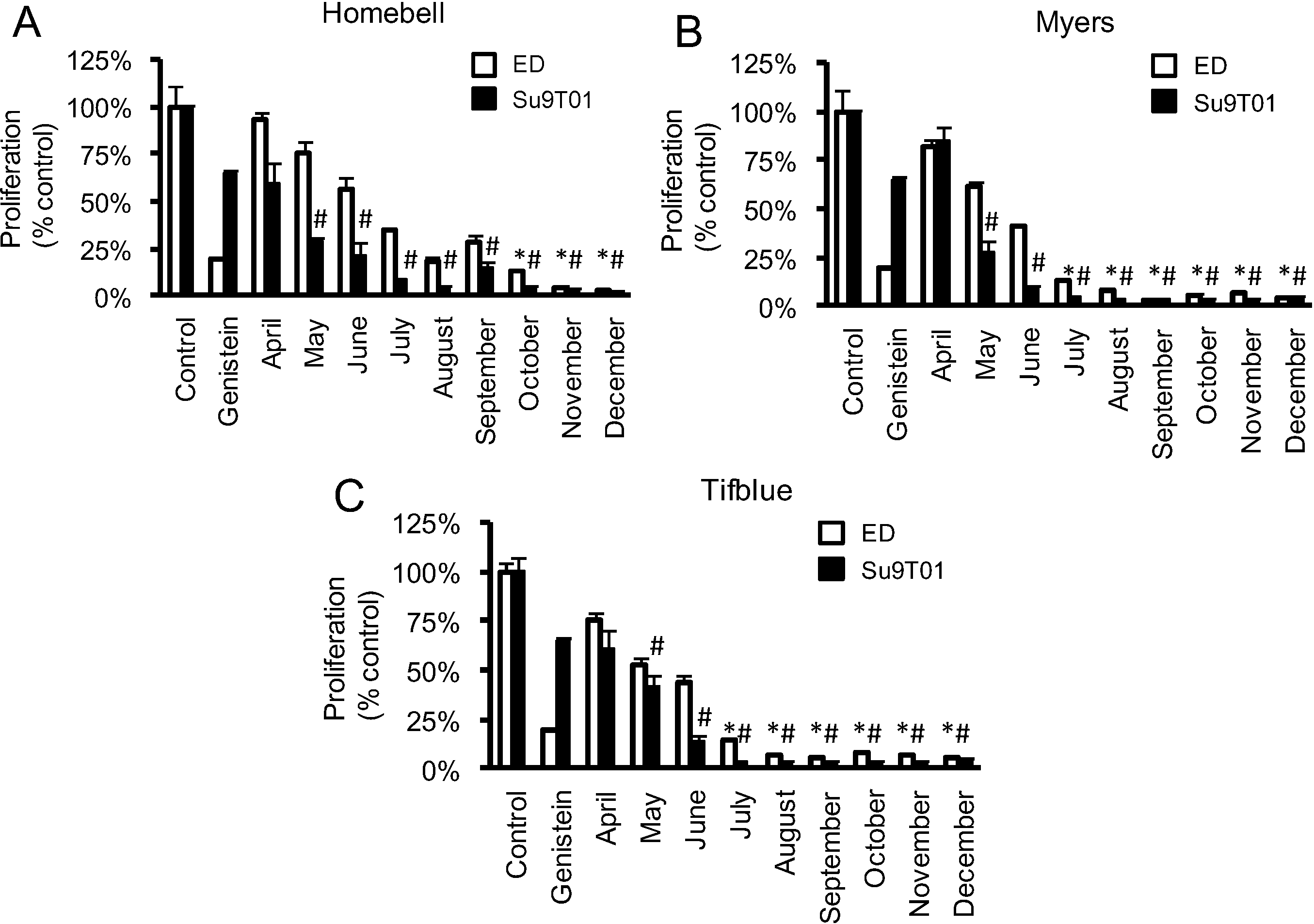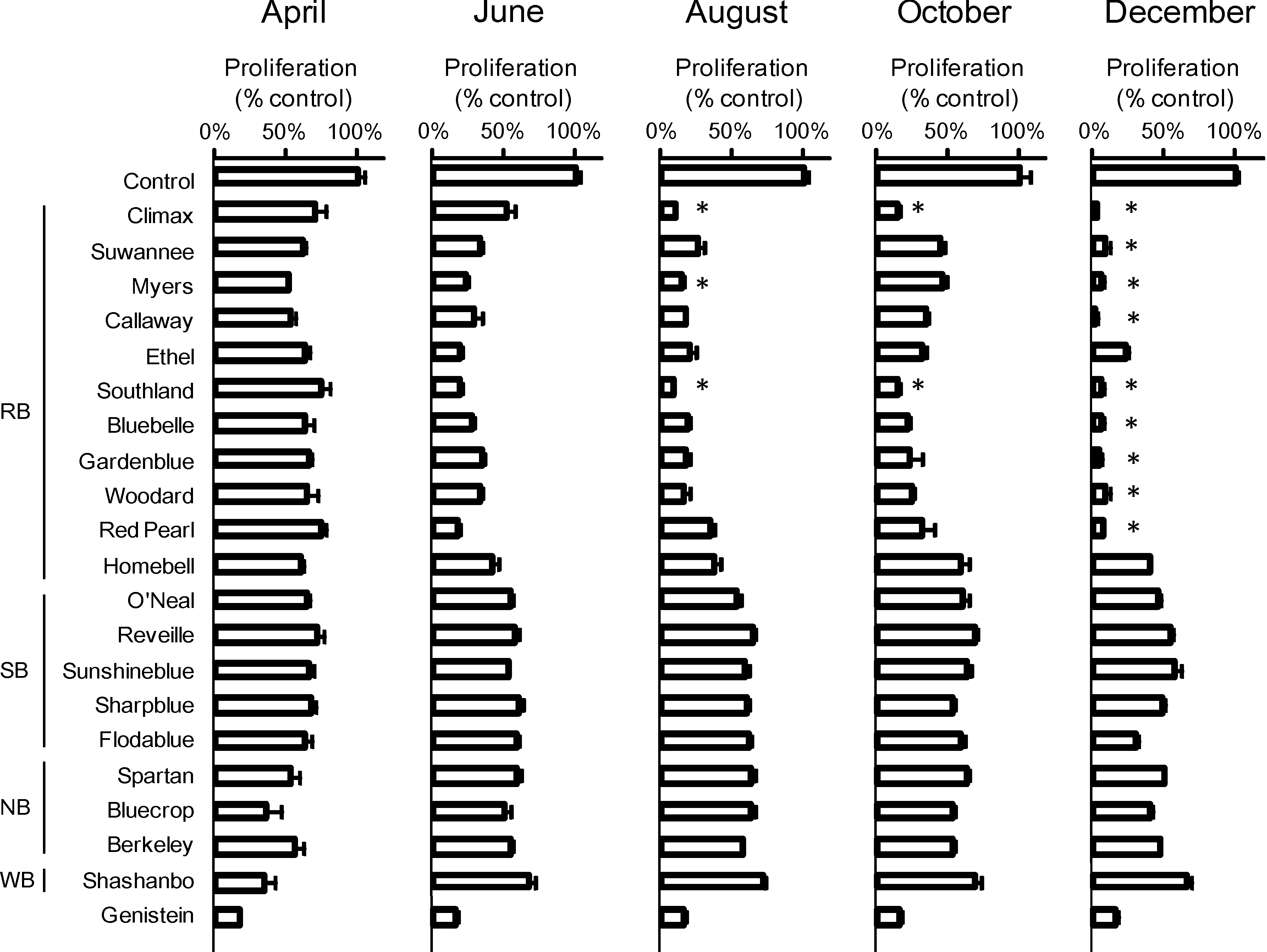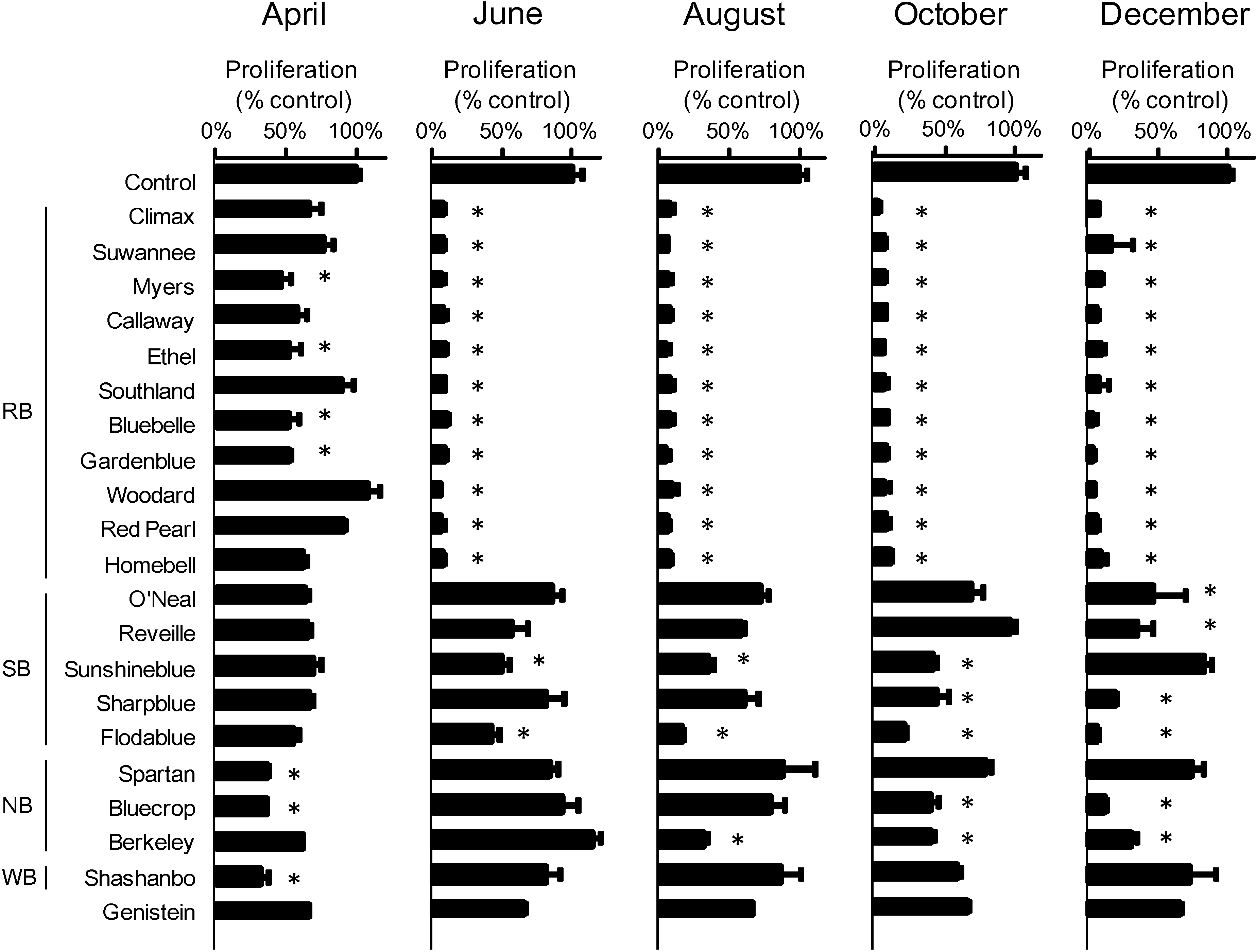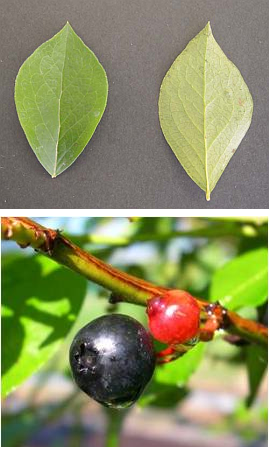Comparison of Cultivars and Seasonal Variation in Blueberry (Vaccinium Species) Leaf Extract on Adult T-Cell Leukemia Cell Line Growth Suppression
Abstract
:1. Introduction
2. Experimental Section
2.1. Plant Materials
| Species | Cultivars | Voucher Number Yield (%) | ||||||||
|---|---|---|---|---|---|---|---|---|---|---|
| April | May | June | July | August | September | October | November | December | ||
| RB | Homebell | RB121 | RB122 | RB123 | RB124 | RB125 | RB126 | RB127 | RB128 | RB129 |
| 48.7% | 37.1% | 40.5% | 37.1% | 39.3% | 43.9% | 40.3% | 44.7% | 41.2% | ||
| Myers | RB131 | RB132 | RB133 | RB134 | RB135 | RB136 | RB137 | RB138 | RB139 | |
| 43.3% | 43.2% | 43.7% | 45.7% | 44.9% | 43.3% | 41.9% | 42.5% | 37.0% | ||
| Tifblue | RB141 | RB142 | RB143 | RB144 | RB145 | RB146 | RB147 | RB148 | RB149 | |
| 39.6% | 33.2% | 38.5% | 30.8% | 36.7% | 35.2% | 34.5% | 37.0% | 34.2% | ||
2.2. Extraction
| Species | Cultivars | Voucher Number Yield (%) | ||||
|---|---|---|---|---|---|---|
| April | June | August | October | December | ||
| RB | Climax | RB011 | RB012 | RB013 | RB014 | RB015 |
| 28.8% | 34.7% | 42.0% | 44.5% | 37.7% | ||
| Suwannee | RB021 | RB022 | RB023 | RB024 | RB025 | |
| 35.6% | 35.0% | 35.5% | 34.2% | 41.6% | ||
| Myers | RB031 | RB032 | RB033 | RB034 | RB035 | |
| 34.1% | 42.8% | 38.5% | 40.9% | 41.6% | ||
| Callaway | RB041 | RB042 | RB043 | RB044 | RB045 | |
| 37.3% | 39.1% | 39.9% | 39.4% | 41.9% | ||
| Ethel | RB051 | RB052 | RB053 | RB054 | RB055 | |
| 32.0% | 40.1% | 43.4% | 39.9% | 34.5% | ||
| Southland | RB061 | RB062 | RB063 | RB064 | RB065 | |
| 25.4% | 40.6% | 40.9% | 41.3% | 35.5% | ||
| Bluebelle | RB071 | RB072 | RB073 | RB074 | RB075 | |
| 28.7% | 37.1% | 41.2% | 40.6% | 43.5% | ||
| Gardenblue | RB081 | RB082 | RB083 | RB084 | RB085 | |
| 36.5% | 46.4% | 41.5% | 42.0% | 38.4% | ||
| Woodard | RB091 | RB092 | RB093 | RB094 | RB095 | |
| 38.2% | 41.9% | 43.0% | 40.0% | 31.1% | ||
| Red Pearl | RB101 | RB102 | RB103 | RB104 | RB105 | |
| 24.2% | 40.5% | 47.0% | 43.3% | 44.2% | ||
| Homebell | RB111 | RB112 | RB113 | RB114 | RB115 | |
| 39.5% | 35.7% | 34.6% | 42.3% | 38.9% | ||
| SB | O’Neal | SB011 | SB012 | SB013 | SB014 | SB015 |
| 25.6% | 34.4% | 32.6% | 32.3% | 26.5% | ||
| Reveille | SB021 | SB022 | SB023 | SB024 | SB025 | |
| 34.2% | 33.1% | 36.0% | 39.0% | 31.2% | ||
| Sunshineblue | SB031 | SB032 | SB033 | SB034 | SB035 | |
| 36.5% | 32.4% | 35.9% | 37.0% | 34.2% | ||
| Sharpblue | SB041 | SB042 | SB043 | SB044 | SB045 | |
| 33.7% | 31.0% | 33.8% | 32.7% | 32.9% | ||
| Flodablue | SB051 | SB052 | SB053 | SB054 | SB055 | |
| 31.1% | 29.4% | 32.0% | 32.7% | 32.0% | ||
| NB | Spartan | NB011 | NB012 | NB013 | NB014 | NB015 |
| 32.7% | 27.9% | 21.4% | 34.9% | 24.3% | ||
| Bluecrop | NB021 | NB022 | NB023 | NB024 | NB025 | |
| 19.0% | 25.2% | 29.9% | 32.5% | 22.1% | ||
| Berkeley | NB031 | NB032 | NB033 | NB034 | NB035 | |
| 25.1% | 33.7% | 32.3% | 32.7% | 30.7% | ||
| WB | Shashanbo | WB011 | WB012 | WB013 | WB014 | WB015 |
| 13.9% | 32.9% | 26.4% | 34.3% | 33.5% | ||
2.3. Cell Culture
2.4. Cell Proliferation Assay
2.5. Statistical Analysis
3. Results and Discussion
3.1. Seasonal Variation in Cell Inhibition of 80% Ethanol Extracts from Leaves of the Rabbit-Eye Blueberry Species (Vaccinium virgatum Aiton; RB Species) Collected in 2006

3.2. Comparison of Cultivars and Seasonal Variation in the Extracts of Blueberry Leaves Collected in 2008 on the Suppression of ATL Cell Growth


4. Conclusions
Acknowledgments
Conflicts of Interest
References
- Arisawa, K.; Soda, M.; Endo, S.; Kurokawa, K.; Katamine, S.; Shimokawa, I.; Koba, T.; Takahashi, T.; Saito, H.; Doi, H.; et al. Evaluation of adult T-cell leukemia/lymphoma incidence and its impact on non-Hodgkin lymphoma incidence in southwestern Japan. Int. J. Cancer 2000, 85, 319–324. [Google Scholar] [CrossRef]
- Proietti, F.A.; Carneiro-Proietti, A.B.; Catalan-Soares, B.C.; Murphy, E.L. Global epidemiology of HTLV-I infection and associated diseases. Oncogene 2005, 24, 6058–6068. [Google Scholar] [CrossRef]
- Yamada, Y.; Tomonaga, M.; Fukuda, H.; Hanada, S.; Utsunomiya, A.; Tara, M.; Sano, M.; Ikeda, S.; Takatsuki, K.; Kozuru, M.; et al. A new G-CSF-supported combination chemotherapy, LSG15, for adult T-cell leukaemia-lymphoma: Japan Clinical Oncology Group Study 9303. Br. J. Haematol. 2001, 113, 375–382. [Google Scholar] [CrossRef]
- Kai, H.; Akamatsu, E.; Torii, E.; Kodama, H.; Yukizaki, C.; Sakakibara, Y.; Suiko, M.; Morishita, K.; Kataoka, H.; Matsuno, K. Inhibition of proliferation by agricultural plant extracts in seven human adult T-cell leukaemia (ATL)-related cell lines. J. Nat. Med. 2011, 65, 651–655. [Google Scholar] [CrossRef]
- Cignarella, A.; Nastasi, M.; Cavalli, E.; Puglisi, L. Novel lipid-lowering properties of Vaccinium myrtillus L. leaves, a traditional antidiabetic treatment, in several models of rat dyslipidaemia: A comparison with ciprofibrate. Thromb. Res. 1996, 84, 311–322. [Google Scholar] [CrossRef]
- McIntyre, K.L.; Harris, C.S.; Saleem, A.; Beaulieu, L.P.; Ta, C.A.; Haddad, P.S.; Arnason, J.T. Seasonal phytochemical variation of anti-glycation principles in lowbush blueberry (Vaccinium angustifolium). Planta Med. 2009, 75, 286–292. [Google Scholar] [CrossRef]
- Kunitake, H.; Tsuda, H.; Takagi, R.; Ohno, Y.; Kuroki, Y.; Yoshioka, K.; Kage, T.; Ito, T.; Komatsu, H. Possibility of wild blueberry shashanbo (Vaccinium bracteatum Thunb.) as a rootstock for cultivation of northern highbush blueberry in warm region. J. Jpn. Soc. Hortic. Sci. 2006, 5, 105–110. [Google Scholar]
- Yamasaki, M.; Fujita, S.; Ishiyama, E.; Mukai, A.; Madhyastha, H.; Sakakibara, Y.; Suiko, M.; Hatakeyama, K.; Nemoto, T.; Morishita, K.; et al. Soy-derived isoflavones inhibit the growth of adult T-cell leukemia cells in vitro and in vivo. Cancer Sci. 2007, 98, 1740–1746. [Google Scholar] [CrossRef]
- Yamasaki, M.; Mukai, A.; Ohba, M.; Mine, Y.; Sakakibara, Y.; Suiko, M.; Morishita, K.; Nishiyama, K. Genistein induced apoptotic cell death in adult T-cell leukemia cells through estrogen receptors. Biosci. Biotechnol. Biochem. 2010, 74, 2113–2115. [Google Scholar] [CrossRef]
- Matsuo, Y.; Fujita, Y.; Ohnishi, S.; Tanaka, T.; Hirabaru, H.; Kai, T.; Sakaida, H.; Nishizono, S.; Kouno, I. Chemical constituents of the leaves of rabbiteye blueberry (Vaccinium ashei) and characterisation of polymeric proanthocyanidins containing phenylpropanoid units and A-type linkages. Food Chem. 2010, 121, 1073–1079. [Google Scholar] [CrossRef]
- Xu, Z.; Du, P.; Meiser, P.; Jacob, C. Proanthocyanidins: Oligomeric structures with unique biochemical properties and great therapeutic promise. Nat. Prod. Commun. 2012, 7, 381–388. [Google Scholar]
- Li, H.C.; Yashiki, S.; Sonoda, J.; Lou, H.; Ghosh, S.K.; Byrnes, J.J.; Lema, C.; Fujiyoshi, T.; Karasuyama, M.; Sonoda, S. Green tea polyphenols induce apoptosis in vitro in peripheral blood T lymphocytes of adult T-cell leukemia patients. Jpn. J. Cancer Res. 2000, 91, 34–40. [Google Scholar] [CrossRef]
© 2014 by the authors; licensee MDPI, Basel, Switzerland. This article is an open access article distributed under the terms and conditions of the Creative Commons Attribution license (http://creativecommons.org/licenses/by/3.0/).
Share and Cite
Kai, H.; Fuse, T.; Kunitake, H.; Morishita, K.; Matsuno, K. Comparison of Cultivars and Seasonal Variation in Blueberry (Vaccinium Species) Leaf Extract on Adult T-Cell Leukemia Cell Line Growth Suppression. Medicines 2014, 1, 3-11. https://doi.org/10.3390/medicines1010003
Kai H, Fuse T, Kunitake H, Morishita K, Matsuno K. Comparison of Cultivars and Seasonal Variation in Blueberry (Vaccinium Species) Leaf Extract on Adult T-Cell Leukemia Cell Line Growth Suppression. Medicines. 2014; 1(1):3-11. https://doi.org/10.3390/medicines1010003
Chicago/Turabian StyleKai, Hisahiro, Takuichi Fuse, Hisato Kunitake, Kazuhiro Morishita, and Koji Matsuno. 2014. "Comparison of Cultivars and Seasonal Variation in Blueberry (Vaccinium Species) Leaf Extract on Adult T-Cell Leukemia Cell Line Growth Suppression" Medicines 1, no. 1: 3-11. https://doi.org/10.3390/medicines1010003






